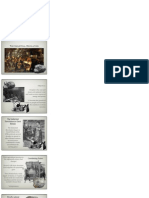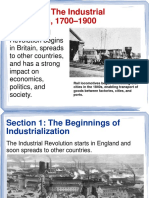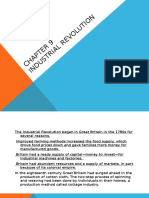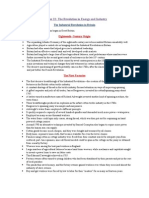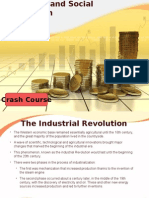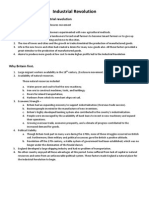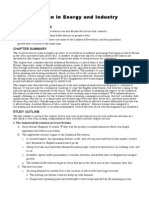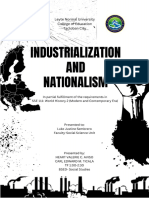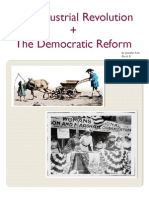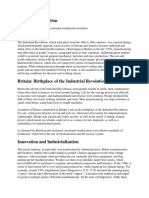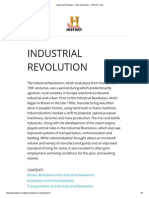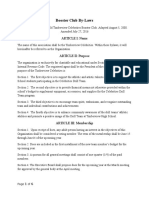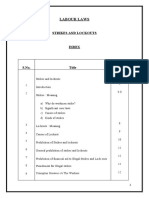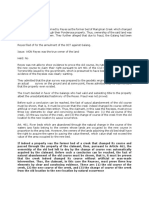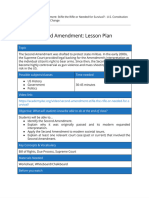Chapter 19 Industrialization and Nationalism, 1800-1870
Section 1
The Industrial Revolution in Great Britain
• The Industrial Revolution began in Great Britain in the 1780s for several reasons.
• Improved farming methods increased the food supply, which drove food prices
down and gave families more money for manufactured goods.
• The increased food supply also supported a growing population.
• Britain had a ready supply of capital–money to invest–for industrial machines
and factories.
• Wealthy entrepreneurs were looking for ways to invest and make profits.
• Finally, Britain had abundant natural resources and a supply of markets, in part
because of its colonial empire.
• A series of inventions–the flying shuttle, the spinning jenny, and the water-
powered loom invented by Edmund Cartwright in 1787–made both weaving and
spinning faster.
• It was now efficient to bring workers to the new machines in factories.
• Cottage industry no longer was efficient.
• The cotton industry became even more productive after the Scottish engineer
James Watt improved the steam engine in 1782 so it could drive machinery.
• Steam power was used to spin and weave cotton.
• Steam-powered cotton mills proliferated throughout Britain.
• The steam engines used coal.
• Mills no longer had to be located near water.
• The steam engine drove Britain’s Industrial Revolution, and it ran on coal.
• This led to the coal industry expanding. The coal supply seemed unlimited.
• Coal also transformed the iron industry.
• Iron had been made in England since the Middle Ages.
• Using the process developed by Henry Cort called puddling, industry produced a
better quality of iron.
• The British iron industry boomed. In 1740 Britain produced 17,000 tons of iron.
• Cort’s process quadrupled production, and by 1852 Britain was producing almost
3 million tons of iron annually.
• Since they were an efficient way to move resources and goods, railroads were
crucial to the Industrial Revolution.
• The first railroads were slow, but they developed rapidly.
• The Rocket was used on the first public railway line, which opened in 1830.
• The 32-miles of track went from Liverpool to Manchester, England.
• The Rocket pulled a 40-ton train at 16 miles per hour.
• Within 20 years, trains were going 50 miles per hour, an incredible speed for
its time. By 1850, Great Britain had more than 6,000 miles of track.
• Building railroads was a new job for farm laborers and peasants.
• The less expensive transportation lowered the price of goods and made for larger
markets.
• More sales meant more demand, which meant more factories and machines.
• This regular, ongoing cycle of economic growth was a basic feature of the
Industrial Revolution.
• The factory was another important aspect of the Industrial Revolution because it
created a new kind of labor system.
• To keep the machines going constantly, workers had to work in shifts.
� • Factory owners trained the rural laborers to work the same hours each day and to
do repetitive work.
• One early industrialist said his goal was “to make the men into machines that
cannot err.”
The Spread of Industrialization
• Britain became the world’s greatest industrial nation.
• It produced one-half of the world’s cotton goods and coal.
• The Industrial Revolution spread to other parts of the world at different speeds.
• Belgium, France, and Germany were the first to industrialize, principally because
their governments built infrastructure such as canals and railroads.
• The Industrial Revolution hit the United States.
• In 1800, six out of every seven American workers were farmers.
• By 1860, the number was only 1 out of every 2.
• Over this period, the population grew from about 5 to 30 million people, and a
number of large cities developed.
• The railroad was the most important transportation development. America had
fewer than 100 miles of track in 1830.
• By 1860 it had about 30,000 miles of track.
• The railroad turned the United States into a massive market.
• Labor for the growing factories came from the farm population.
• Many of the new factory workers were women and girls, who made up a
substantial majority of the workers in textile factories.
• Factory owners sometimes had whole families work for them.
Social Impact in Europe
• The Industrial Revolution spurred the growth of cities and created two new social
classes: the industrial middle class and the industrial working class.
• Europe’s population nearly doubled between 1750 and 1850 to 266 million.
• The chief reason was a decline in death from disease.
• The increased food supply fed the people better, and famine largely disappeared
from western Europe.
• The Industrial Revolution replaced the commercial capitalism of the Middle Ages
with industrial capitalism–an economic system based on industrial production.
• This capitalism produced the industrial middle class.
• It was made up of the people who built the factories, bought the machines, and
figured out where the markets were.
• Their characteristics were initiative, vision, ambition, and money making.
• In Britain, women and children made up two-thirds of the cotton industry’s
workforce.
• The Factory Act of 1833 set 9 as the minimum age to work.
• Children from ages 9 to 13 could work only 9 hours a day; those between ages 13
and 18 could work only 12 hours.
• Women took more and more of the textile industry jobs.
• They were unskilled and were paid half or less than the men.
• Excessive working hours for women were outlawed in 1844.
• The employment of women and children was a holdover from the cottage industry
system.
• The laws restricting industrial work for women and children led to a new pattern
of work, therefore.
� • Married men were now expected to support the family, and married women were
to take care of the home and perform low-paying jobs in the home, such as taking in
laundry, to help the family survive.
• The pitiful conditions for workers in the Industrial Revolution led to a movement
called socialism.
• Under socialism, society, usually government, owns and controls some means of
production–such as factories and utilities.
• Early socialism was largely the idea of intellectuals who believed in the equality
of all people and who wanted to replace competition with cooperation.
• Later socialists like Karl Marx thought these ideas were not practical and called
those who believed them utopian socialists.
Section 2
The Congress of Vienna
• When the great powers of Austria, Prussia, Russia, and Great Britain met at the
Congress of Vienna in 1814, they wanted to restore the old order after
Napoleon’s defeat.
• Prince Klemens von Metternich was the Austrian foreign minister who led the
Congress.
• He said he was guided at Vienna by the principle of legitimacy: legitimate
monarchs deposed by Napoleon would be restored in the interest of peace and
stability.
The Conservative Order
• The arrangement worked out at the Congress of Vienna curtailed the forces set
loose by the French Revolution.
• Those who saw this as a victory, such as Metternich, held a political philosophy
called conservatism.
• Conservatism is based on tradition and social stability.
• Conservatives wanted obedience to traditional political authority and believed that
organized religion was important to an ordered society.
• They did not like revolution or demands for rights and government representation.
• Most of the great powers eventually adopted the principle of intervention:
countries had a right to intervene where revolutions were threatening monarchies.
• Britain rejected the principle, saying countries should not interfere in the internal
affairs of other states.
• Austria, Prussia, Russia, and France did crush revolutions and restore monarchies.
Forces of Change
• The forces of liberalism and nationalism were gathering to bring about change in
the old order.
• Liberalism is based principally on Enlightenment principles and held that people
should be free of government restraint as much as possible.
• The chief liberal belief was the importance of protecting the basic rights of all
people.
• Liberals believed these civil rights should be guaranteed, as they are in the
American Bill of Rights.
• Nationalism was an even more powerful force for change in the nineteenth
century.
• It arose out of people’s awareness of belonging to a community with common
institutions, traditions, language, and customs.
• This community is called a nation.
� • In the view of nationalists, citizens owe their loyalty to the nation, not a king or
other entity.
• Nationalists came to believe that each nationality should have its own
government.
• Countries that were divided into principalities, as Germany was, should have
unity with a centralized government; subject people, such as the Hungarians,
should have their own nation.
• Conservatives feared what such changes would do to the balance of power in
Europe and to their kingdoms.
• The conservatives repressed the nationalists.
• In the first half of the nineteenth century, liberalism was a strong ally of
nationalism because liberals believed in self-government.
• This alliance gave nationalism a wider scope.
The Revolutions of 1848
• Despite changes after 1830, the conservative order still dominated much of
Europe.
• The growing forces of nationalism and liberalism erupted again in the revolutions
of 1848.
• In Europe in 1848, popular revolts led to constitutional governments.
• The revolutionaries could not stay united, however, and conservative rule was
reestablished.
Section 3
Breakdown of the Concert of Europe
• The nationalist goals of the 1848 revolutionaries would be achieved later.
• By 1871 both Germany and Italy were unified, a change caused by the Crimean
War.
• The Crimean War was rooted in a conflict between Russia and the Ottoman
Empire, which controlled much of the Balkans in southeastern Europe.
• The power of the Ottoman Empire declined in the nineteenth century.
• Russia wanted to expand into the Balkans so it could have access to the
Dardanelles and the Mediterranean Sea, giving it the naval might to be the great
power in eastern Europe.
• Russia invaded the Turkish Balkan provinces of Moldavia and Walachia, and the
Ottomans declared war on Russia.
• Great Britain and France, fearing Russia’s ambitions, allied with the Ottomans.
• The Crimean War was on.
• The Crimean War destroyed the Concert of Europe.
• Austria and Russia had been the two powers maintaining order, but now they
were enemies because Austria had not supported Russia in the Crimean War due
to its own interests in the Balkans.
• Russia withdrew from European affairs for the next 20 years.
• Austria had no friends among the great powers, and Germany and Italy now could
unify.
Italian Unification
• In 1850, Austria was still the dominant power on the Italian Peninsula.
• After 1848, people looked to the northern Italian state of Piedmont to lead the
fight for unification.
• The king of Piedmont named Camillo di Cavour his prime minister.
� • Cavour pursued economic expansion, which gave the government enough money
to support a large army.
• He then made an alliance with the French emperor Louis-Napoleon, knowing his
army by itself could not defeat Austria, and provoked the Austrians into declaring
war in 1959.
• The conflict resulted in a peace settlement that made Piedmont an independent
state.
• Cavour’s success caused nationalists in other northern Italian states to overthrow
their governments and join their states to Piedmont.
• In southern Italy, a new patriotic leader for unification emerged–Giuseppe
Garibaldi.
• He raised an army of one thousand volunteers, called Red Shirts because of the
color of their uniforms.
• Garibaldi turned his conquests over to Piedmont, and in 1861 a new Kingdom
of Italy was proclaimed.
• King Victor Emmanuel II, who had been king of Piedmont, was crowned ruler.
German Unification
• Germans looked to Prussia’s militarismfor leadership in unification.
• In the 1860s, King William I tried to enlarge the already powerful Prussian army.
• When the legislature refused to levy the tax, William I appointed a new prime
minister, Otto von Bismarck.
• Bismarck often is seen as the greatest nineteenth-century practitioner of
realpolitik, or practical politics with little regard for ethics and an emphasis on
power.
• He ignored the legislature on the matter of the army, saying that “Germany does
not look to Prussia’s liberalism but to her power.”
• Prussia dominated all of northern Germany.
• Problems with France soon developed.
• France feared a strong German state.
• From a misunderstanding between Prussia and France over the candidacy of a
relative of the Prussian king for the throne of Spain, the Franco-Prussian War
broke out in 1870.
• Prussia and its southern German allies handily defeated the French.
• Prussian armies advanced into France, capturing the king (Napoleon III) and an
entire army.
• Paris surrendered, and an official peace treaty was signed in 1871.
• France paid 5 billion francs and gave up the provinces of Alsace and Lorraine to
the new German state.
• The French burned for revenge over the loss of these territories.
• The southern German states joined the North German Confederation.
• On January 18, 1871, in the Hall of Mirrors in the palace of Versailles, William I
of Prussia was proclaimed kaiser, or emperor, of the Second German Empire (the
first was the Holy Roman Empire).
• The Prussian monarchy and army had achieved German unity, giving the new
state its authoritarian and militaristic values.
• This military might combined with industrial resources made the new state the
strongest power on the European continent.
Nationalism and Reform in Europe
� • Great Britain avoided the revolutionary upheavals of the first half of the
nineteenth century.
• In 1815 the aristocratic classes dominated Parliament.
• In 1832 Parliament extended the vote to include male members of the industrial
middle class, giving them an interest in ruling Britain.
• Further social and political reforms stabilized Britain through the 1860s.
• Britain’s continued economic growth also added to its stability.
• After 1850, the industrial middle class was prosperous, and the wages of the
industrial working class were beginning to climb.
• The British feeling of national pride was reflected in Queen Victoria.
• Her reign from 1837 to 1901 is the longest in English history.
• Her sense of duty and moral respectability were reflected in her era, known as the
Victorian Age.
• After 1848, events in France moved towards restoring the monarchy.
• In the 1852 plebiscite, or popular vote, 97 percent voted to restore the empire.
• Louis-Napoleon became Napoleon III, emperor of the Second Empire.
• Opposition to the emperor arose in the 1860s.
• Napoleon III liberalized his regime, giving the legislature more power, for
example.
• After the Prussians defeated the French, however, the Second Empire fell.
• The multinational state of Austria had been able to frustrate the attempts of its
ethnic groups for independence.
• After 1848 and 1849, the Hapsburg rulers restored centralized, autocratic
government.
• However, the Prussian victory over Austria forced Austria to make concessions to
the strongly nationalistic Hungarians.
• The result was the Compromise of 1867.
• It created the dual Austria-Hungary monarchy.
• Each component had its own constitution, legislature, bureaucracy, and capital–
Vienna for Austria and Budapest for Hungary.
• At the beginning of the nineteenth century, Russia was a highly rural, autocratic
state with a divine-right monarch with absolute power.
• In 1856, however, Russia was defeated in the Crimean War.
• Even conservatives knew that Russia was falling behind western Europe and
needed to modernize.
• Czar Alexander II made reforms.
• On March 3, 1861, he freed the serfs with an emancipation edict.
• Peasants could now own property and marry as they wished.
• The government bought land from the landlords and provided it to the peasants.
• A group of radicals assassinated Alexander II in 1881.
• His son and successor turned against reform and returned to the old methods
of repression–soldiers, secret police, censorship, and the like.
Nationalism in the United States
• By the mid-nineteenth century, the issue of American unity was threatened by
slavery.
• The South’s economy was based on growing cotton using slave labor, and the
South was determined to keep the status quo.
• Abolitionism, a movement to end slavery, arose in the North and challenged the
South.
� • In 1858 Abraham Lincoln had said that “this government cannot endure
permanently half slave and half free.”
• He was elected president in 1860.
• A month later South Carolina voted to secede (withdraw) from the United States.
• Six more southern states did the same, setting up the rival Confederate States of
America.
• War broke out between North and South.
• The American Civil War (1861 to 1865) was bloody. Over 600,000 soldiers died.
• The Union wore down the Confederacy.
• In 1863, President Lincoln issued the Emancipation Proclamation, freeing the
slaves.
• On April 9, 1865, the South surrendered and national unity prevailed in the
United States.
The Emergence of a Canadian Nation
• After two Canadian rebellions against the government in 1837 and 1838, the
British Parliament formally joined Upper and Lower Canada into the United
Provinces of Canada.
• It was not self-governed.
• John Macdonald, the head of Upper Canada’s Conservative Party, was a strong
voice for self-rule.
• The British gave in, fearing American designs on Canada.
• In 1867, Parliament passed the British North America Act, which established
the new nation, the Dominion of Canada. It had its own constitution.
• John Macdonald was the first prime minister of the new Dominion.
• Canada possessed a parliamentary system and ruled itself, though foreign affairs
were in the hands of the British government.
Section 4
Romanticism
• At the end of the eighteenth century, the intellectual movement known as
romanticism emerged in reaction to Enlightenment ideas.
• The Enlightenment had stressed reason for discovering truth.
• The romantics emphasized feelings and imagination as sources of knowing.
• Many romantics also had a deep interest in the past and revived medieval
architectural styles, such as the Houses of Parliament in London.
• Sir Walter Scott’s novel of clashes among medieval knights, Ivanhoe, was wildly
popular.
• By focusing on their nation’s past, many romantic writers reflected nineteenth-
century nationalism.
• Romantics viewed poetry as the direct expression of the soul.
• Romantic poetry gave expression to a vital part of romanticism, the love of
nature.
• This is clearly seen in the poetry of William Wordsworth.
• The worship of nature caused romantics to criticize the new science, which they
believed reduced nature to a cold object of mathematical study that had no room
for the imagination or the human soul.
A New Age of Science
• The Industrial Revolution increased interest in scientific research.
• By the 1830s science had made discoveries that benefited all Europeans.
� • The Frenchman Louis Pasteur proposed the germ theory of disease, laying the
foundation for modern medical research.
• The Russian Dmitry Mendeleyev classified all the material elements then known
by their atomic weights.
• The Englishman Michael Faraday was laying the foundation for the use of electric
current.
• Europeans’ increasing faith in science and the material world weakened their
religious faith.
• Secularization increased throughout the nineteenth century.
• No one did more to create a picture of humans as material beings than Charles
Darwin.
• In 1859 Charles Darwin published his On the Origin of Species by Means of
Natural Selection.
• Darwin proposed his principle of organic evolution.
• Species of animals and plants develop through a struggle for existence.
• Those that adapt better survive, in a process Darwin called natural selection.
• Darwin argued in The Descent of Man that human beings had animal origins.
• Darwin’s ideas were controversial, but over the years many scientists and
intellectuals have accepted them.
Realism
• The belief that the world should be viewed realistically is related to the scientific
outlook and the modern “politics of reality.”
• Realism became a movement in the arts as well.
• The British novelist Charles Dickens wrote highly successful realist novels
focusing on the lower and middle classes in Britain’s early Industrial Age.
• He described the brutal realities of urban poverty.


